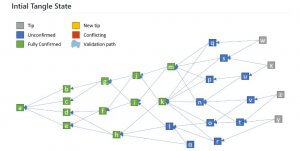The IOTA protocol is an open-source distributed ledger that’s built with the Internet of Things (IoT) in mind – with feeless microtransactions and data integrity for machines. The IOTA protocol is designed to overcome an issue that it sees as intrinsically problematic in the crypto space: scalability.
Scalability is an issue that refers to cryptocurrency networks that cannot handle mainstream levels of payments. For example, Bitcoin can only handle a finite amount of transactions which means it cannot perform on the same level as PayPal or Visa.
With the Lightning Network – a layer 2 scaling solution – this issue is alleviated for Bitcoin. However, the IOTA protocol has been built specifically so that it does need to rely on a scaling solution to solve this issue.
What is the IOTA protocol?
Most cryptocurrency projects rely on blockchain technology – otherwise known as distributed ledger technology (DLT) – to process and verify transactions. Transactions are grouped together into ‘blocks’ of information. It is then the data miners jobs to sift through the transactions and verify them. However, miners require fees for their services.
Mining fees are essential in providing an incentive for the miners. This, twinned with the issue of scalability, is why IOTA chose to not use a blockchain. The IOTA protocol is a distributed ledger for the Internet of Things (IoT). In place of a conventional blockchain, IOTA utilises a ‘directed acrylic graph’ (DAG).
It has a quantum-proof protocol known as ‘the Tangle.’ The IOTA Tangle DAG has no fees on transactions and no fixed limit on how many transactions can be confirmed per second. The throughput will grow in tandem with activity in the network. The more activity that occurs will result in a faster network.
How does the Tangle work?
Without a blockchain there are no blocks of transactions to be processed and verified by miners. Instead IOTA protocol transactions are confirmed by one or more following transactions. This is because the Tangle requires two parent transactions. Consequently, the structure of the network can be charted as a direct graph with zero directed cycles. Below is a visual representation of how the network could look, taken from the IOTA website.

To partake in the network, all users need to do is perform a small amount of computational work that verifies two previous transactions. This voids the network of a hierarchical structure which in turn results in everybody having equal incentives and rewards.
The IOTA websites dubs this ‘pay-it-forward.’ The concept is simple: verify two transactions and your reward is your own transaction. While this might sound like a somewhat tedious process, it also removes the need to offer financial rewards. The fees will be negligible.
Since it is not money orientated, it can also securely store information within the Tangle transactions – so it is not limited to transactional value settlements. The more people that are active on the network results in faster transactions – however this does not come without a cost. The network is entirely reliant on people confirming two previous transactions, if somebody is looking to quickly make a transaction they will choose another network.
How do you know if a transaction can be trusted?
In conventional blockchains, people know how much they can trust a block of transactions based on the number of confirmations. Without blocks of transactions/information, the IOTA protocol functions differently.
Instead transactions have a weight and cumulative weight. A transactions weight determines how much computational work needs to be done to validate the transaction. The cumulative weight refers to the weight of a transaction and the sum weight of the transactions which have approved the first transaction.
Below is a visual representation of weighted transactions, taken from the IOTA consensus GitHub.

The image displays transactions coloured in green as ‘fully confirmed’ while the ones coloured blue are ‘unconfirmed’ which means it is only partially confirmed. Grey or yellow coloured ones indicate that the transaction is yet to have confirmation work done on it.
It does not show a transaction coloured in red, but if it did that transaction would be noted as ‘conflicting’ to signify something might be wrong or it is invalid. Finding trusted transactions will require the user to examine the weight and cumulative weight of a transaction to make their estimate on whether they want to confirm it.
Hashcase Lite
Proof-of-Work (PoW) algorithms are used in a range of crypto projects, Bitcoin included. PoW helps prevent spam attacks. Hashcash is a piece of technology used in PoW. It includes solving a puzzle. Computer devices must successfully guess an alphanumeric code known as the ‘nonce.’ Hashing power determines how quickly and easy the puzzle is to solve. Faster processing requires more computing power.
In Bitcoin, PoW is used to confirm and verify transactions. However, IOTA utilises Hashcash Lite which means many types of computer devices can use the IOTA platform.
It pays to do research
Hopefully this introduction to the IOTA protocol has helped you understand how it is an alternative to blockchain technology.
Before making any decisions regarding the IOTA protocol or any crypto project/network ensure you do adequate research.
We do not make any recommendation on cryptocurrencies, networks or projects and as such you could never do too much research. Ultimately you are responsible for the decisions you undertake.
Interested in reading more about different blockchains? Discover more about Skycoin and decentralised internet with our guide on the subject.
Disclaimer: The views and opinions expressed by the author should not be considered as financial advice. We do not give advice on financial products.
